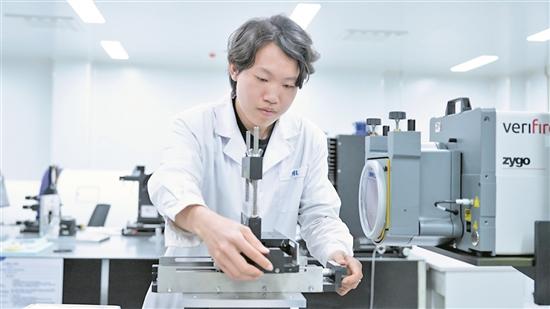
The technical workforce is a crucial force supporting both Made in China and Created in China.
In Guangdong, there is a group of highly skilled talents who collaborate with top domestic and international researchers. They actively participate in national-level major projects to enhance the efficiency of scientific and technological research and development.

One of them is Tan Jiahui from Ji Hua Laboratory. In 2021, after graduating from a technician institute, Tan Jiahui came across recruitment for skilled talents at Ji Hua Laboratory and entered the field of optics out of curiosity. In the research and development of the high-precision ion beam shaping equipment project for freeform surface, mirror processing posed a challenge. "Due to the freeform surface of the mirror, which is asymmetric in all directions, the machine's head might collide with the mirror, resulting in irreparable consequences," Tan said. He continuously adjusted its trajectory through simulation and correction to ensure no collisions during formal processing, finally achieving a mirror accuracy of ten nanometers.

At the 44th World Skills Competition, Liang Jiawei clinched the gold medal in the Information Network Cabling category, marking China's first-ever gold medal in this event. After the competition, he actively applied various innovative techniques he independently developed, transforming himself into an expert guiding rural new infrastructure projects.
After the competition, Liang Jiawei returned to his hometown of Zhongshan and led a team to assist in addressing technical challenges in rural new infrastructure, contributing to the renovation of the "three networks" (electricity, communication, and broadcasting television lines) in rural areas."Rural new infrastructure aims to organize the rural network into a neat and aesthetically pleasing structure while optimizing and upgrading copper and fiber optic cables in villages," Liang explained. "This ensures that every resident can access the fastest and most optimal network."
From the Hong Kong-Zhuhai-Macao Bridge to the Shenzhen-Zhongshan Link, from the "Canton Tower" to the world's largest high-speed rail station, from China Spallation Neutron Source dubbed as a "super microscope" to the world's largest river-sea mobile dock, each of these century-spanning projects is supported by millions of skilled professionals.
As a leading economic and manufacturing province, Guangdong enjoys unique advantages in the development of skilled talent. According to statistics, Guangdong currently hosts 71,000 large-scale industrial enterprises and 75,000 high-tech enterprises. It possesses eight trillion-yuan-level industrial clusters including next-generation electronic information industries. Across China, one in every three industrial robots and four new energy vehicles feature is made in Guangdong. Additionally, over 70% of consumer-grade drones worldwide originate from Guangdong.
In terms of talent cultivation, Guangdong adheres to the principle of "training talents according to industry needs." Statistics show that Guangdong has a total of 19.79 million skilled talents, including 6.9 million highly skilled individuals. Currently, there are 148 technician institutes in Guangdong. These collaborate closely with over 100 Fortune Global 500 companies and more than 800 large domestic enterprises, implementing a widespread model of "school-enterprise cooperation intalent training".
Source:Yangcheng Evening News
参与科研项目、解决基建难题......看广东技能人才发展之路
技术工人队伍是支撑中国制造、中国创造的重要力量。
在广东,有这么一群高技能人才,与国内外顶尖科研人才一起共事。他们积极参与国家级重大项目,提高科技研发效率。
来自季华实验室的谭家辉就是其中之一。2021年,谭家辉从技师学院毕业后,看到季华实验室技能人才招聘信息,抱着好奇的心态闯入了光学领域。在面向自由曲面的高精度离子束修形装备研制项目研发中,镜子加工是难点。“由于镜子的面是自由曲面,上下左右都不对称,加工时机器的头可能会磕碰到镜子,带来无法挽回的后果。”谭家辉说,他通过模拟、修正,不断调整镜子的运行轨迹,确保正式加工时不产生磕碰,最后成功将镜子的精度做到10纳米。
在第44届世界技能大赛上,梁嘉伟一举斩获信息网络布线项目的金牌,实现了中国在该赛项金牌“零”的突破。走下赛场,他将自主研发创新的多种技巧积极转化,摇身一变成为乡村新基建指导专家。
世赛结束后,梁嘉伟回到家乡中山,带领团队协助解决乡村新基建技术难题,助力农村“三线”(即电力线、通信线、广播电视线)整治。“乡村新基建,就是要把农村像蜘蛛网一样的线归纳起来,变得整齐美观,同时优化和改造乡村的铜缆和光缆,让每一个老百姓都可以用到最快最优的网络。”梁嘉伟说。
从港珠澳大桥到深中通道,从珠江畔的“小蛮腰”到“全球最大高铁站”,从被称为“超级显微镜”的中国散裂中子源到全球最大江海移动船坞,一个个世纪工程的背后是百万技能人才的支撑。
作为经济大省、制造业大省,广东技能人才发展优势得天独厚。据统计,广东目前有7.1万家规上工业企业、7.5万家高新技术企业,拥有新一代电子信息等8个万亿级产业集群,全国每3台工业机器人、每4台新能源汽车就有1台“广东造”,全球七成以上消费级无人机产自广东。
在人才培养方面,广东坚持“产业需要什么样的人才,学校就培养什么样的人才”。据统计,广东技能人才总量达到1979万人,其中高技能人才690万人。目前,广东共有148所技工院校,全省技工院校与100多家世界500强企业及国内800多家大型企业深入开展校企合作,普遍推行“校企双师联合培养”的模式。
文、图|记者 周聪 通讯员 粤仁宣
译 | 林佳岱
-
Poster | With more than 70,000 ginger lotus blooming, the 2nd Ginger Lotus Cultural Festival opened in Baiyun, Guangzhou!
2024-07-18 21:37:40 -
Cutting-edge technologies in Paris 2024 from Shenzhen
2024-07-17 22:10:02 -
Poster丨Heading South! Let's head to Nansha to enjoy a wonderful summer trip
2024-07-17 21:13:38 -
DATA TALK | Nine municipalities of Guangdong in the Greater Bay Area logged record foreign trade in H1
2024-07-17 22:10:08






